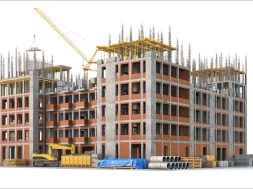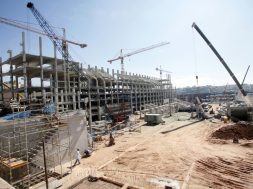Look at the Mount Everest, which tells how beautiful the nature can be. The same nature, however, has rocked the scenic mountain country with a magnitude-7.3 earthquake, killing more than 8,000 people and injuring more than 17,800. About 600,000 homes were destroyed or damaged in that quake.
Two quakes, a week apart, ripped Nepal to debris and several Indian states and cities felt the impact. In some places, there were even incidents of damage to old structures and ill-planned buildings. These recent earthquakes have made home owners and prospective buyers wonder about the earthquake-resistance factors in Indian real estate.
India and earthquake-proof buildings More than 54 per cent of the Indian landmass is prone to earthquake. The reason for this high amount of exposure is the increasing intensity at which the Indian pelagic plate is driving into mainland Asia. The United Nations and World Bank estimate that by 2050, more than 200 million Indian homes would have experiences earthquakes and storms.
The most vulnerable cities are Srinagar and Guwahati, which have been categorised under “very severe intensity” zones. Apart from these two, 36 other Indian cities have been identified to be vulnerable to earthquakes. These include Kolkata, Dhanbad, Patna, Dehradun, Jalandhar, Jamnagar, Surat, Pune, Mangalore, Kochi, Trivandrum, Chennai, Vijayawada, Jabalpur and Bhubaneswar, among others. Some of these are also among the most important and highly populated cities of the country.
Minimising impactNo one can make structures “earthquake proof” but certainly can make them better to withstand the impact and help us avoid the morbid situations. “Adverse impact of the earthquakes can never be fully eliminated but can certainly be minimised to great extent,” says Dr PR Swarup, Director General, Construction Industry Development Council. “A simple analogy is to use a raincoat or an umbrella to avoid getting overtly wet. It is an essential requirement that any structure, leave alone the buildings, need to be conceived, designed, constructed to withstand all kind of loads, and the resultant stresses and strains.”
Earthquake-proof buildings Earthquake-proof buildings have deep strong base and are lighter in loads than traditional constructions. Special beaming and bracing make them resistant to the kinds of sideways movements that are experienced in the event of an earthquake. “Construction techniques adopted are of extreme importance and faulty execution in spite of excellent design could mar the objectives,” adds Mr Swarup. “To employ and engage skill trained, tested, and certified work persons and qualified engineering staff is the third essential requirement”Structures — whether earthquake resistant or not — are like human body which needs regular check-up. This is true for structures too. “Checking the defects periodically and resorting to effective retrofitting is therefore the fourth essentiality,” says Mr Swarup.
Design principlesTo make a structure earthquake resistant, there are various concepts used around the globe:• Base Isolation System: This separates the foundation of a building from the actual structure. It uses rubber bearings which act as seismic isolators during a tremor. If earthquake occurs, only the foundation will slide, but the actual construction will stay intact. The rubber bearings also absorbs shake and cut down the intensity of the impact.• Dampers: Like the big shock absorbers in vehicles, they dissipate the total energy across the base of the building and keep the top structure safe. These are generally used in high-rise buildings and for retrofitting older buildings.• Levitation: When an earthquake strikes, levitation engineering lifts the building which is built on a deflated air bag. When an earthquake strikes, the air bags pump up and build air space of a few centimetres between the house and the ground, reducing earthquake impact.
Although there is no 100 per cent earthquake-proof residential building, the best that can be achieved is a standardised level of earthquake resistance. Most Indian buildings can sustain 4.0-magnitude earthquake. If the quake registers 9.0 on the Richter scale, very few would exist.
Builders’ responsibility in earthquake-resistance propertiesBuilders are the creator of buildings and play an important role in constructing earthquake-resistant properties. For example, Mumbai comes under the seismic zone 3 category and needs to have buildings that can withstand an earthquake of higher magnitude. It means that the building should be sturdy enough to bear the shock of earthquake. Builders like Marathon has adopted shear wall technology for all its high-rise buildings. Also, all the beam columns junction are specially designed to take horizontal forces during earthquakes. The structure should be stiff so that there is minimum sway in the building .
Mayur Shah, Managing Director, Marathon Group, shares how a builder can contribute towards building earthquake resistance properties. He lists out some important procedures laid down by the authorities:• Before starting with construction of the structure, the building should conduct soil testing and carry out detailed research analysis on the required strength of the structure.• They should use lightweight materials, such as air-entrapped blocks for walling, floors, walls and partitions can be very helpful in such cases.
In order to make the structure durable and strong, Kalpataru Ltd., a leading premium real estate company in India, uses chilled concrete for foundations which reduces shrinkage and increases the speed of casting. Most of its buildings are constructed as monolithic RCC structures using imported aluminium formwork. Eco-friendly materials like flyash and GGBS are added to concrete to increase durability and strength of the RCC structure.____________________________Top 20 Cities for Number of FatalitiesTop 20 Cities for Number of FatalitiesThe ranking by research group GeoHazards International, considering building frailty and rescue and medical care abilities of local authorities. The results are based upon a 6.0 level quake.Kathmandu, Nepal, population 1 million and growing; possible 69,000 deathsIstanbul, Turkey, population 10 million; possible 55,000 deathsDelhi, India, population 14 million; possible 38,000 deathsQuito, Ecuador, population 1.8 million; possible deaths 15.000; volcanoes are an even bigger threat hereManila, Philippines, 1.6 million population; possible 13,000 deathsIslamabad/Rawalpindi, Pakistan, population 1 million; possible 12,500 deathsSan Salvador, El Savador, population, 2.2 million; 11,500 possible deathsMexico City, Mexico, 2.2 million people; possible 11,500 fatalitiesIzmir, Turkey, 3.5 million people; possible 11,500 fatalitiesJakarta, Indonesia, 18.4 million (and expected to hit 24 million by 2025); an estimated 11,000 fatalitiesTokyo, Japan, (has been struck by quakes in 1703,1782, 1812, 1855, 1923) estimated 9,000 fatalitiesMumbai, India, estimated 8,000 fatalitiesGuayaquil, Ecuador, estimated 4,300 fatalitiesBandung, Indonesia, estimated 3,600 fatalitiesSantiago, Chile, estimated 2,700 fatalitiesTashkent, Uzbekistan, estimated 2,500 fatalitiesTijuana, Mexico, estimated 1,800 fatalitiesNagoya, Japan, estimated 900 fatalitiesAntofagasta, Chile, estimated 800 fatalitiesKobem Japan, estimated 300 fatalities
20
Cookie Consent
We use cookies to personalize your experience. By continuing to visit this website you agree to our Terms & Conditions, Privacy Policy and Cookie Policy.









